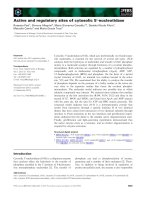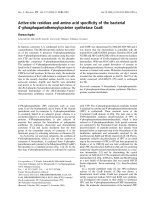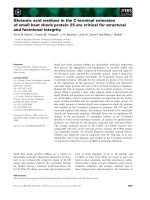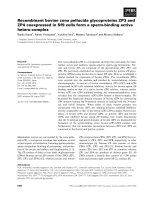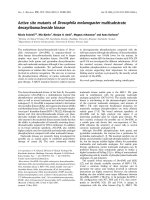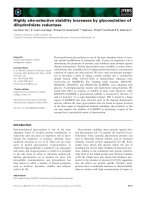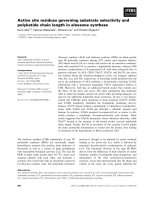Báo cáo khoa học: Active site residues governing substrate selectivity and polyketide chain length in aloesone synthase docx
Bạn đang xem bản rút gọn của tài liệu. Xem và tải ngay bản đầy đủ của tài liệu tại đây (458.2 KB, 11 trang )
Active site residues governing substrate selectivity and
polyketide chain length in aloesone synthase
Ikuro Abe
1,2
, Tatsuya Watanabe
1
, Weiwei Lou
1
and Hiroshi Noguchi
1
1 School of Pharmaceutical Sciences, and the COE21 Program, University of Shizuoka, Japan
2 PRESTO, Japan Science and Technology Agency, Japan
The chalcone synthase (CHS) superfamily of type III
polyketide synthases (PKSs) are structurally simple
homodimeric proteins that produce basic skeletons of
flavonoids as well as a variety of plant polyphenols
with remarkable biological activities [1,2]. The type III
PKSs of plant origin usually share 50–75% amino acid
sequence identity with each other, and maintain a
common 3D overall fold with an absolutely conserved
Cys-His-Asn catalytic triad. The polyketide formation
reaction is thought to be initiated by starter molecule
loading at the active site Cys, which is followed by
sequential decarboxylative condensations of malonyl-
CoA. The functional diversity of the type III PKSs
derives from the differences of their selection of starter
substrate, number of polyketide chain elongations, and
mechanisms of the final cyclization ⁄ aromatization
reactions. It has been demonstrated that the shape and
volume of the active site cavity greatly influence the
Keywords
type III polyketide synthase; chalcone
synthase superfamily; aloesone synthase;
chalcone synthase; engineered biosynthesis
Correspondence
I. Abe, School of Pharmaceutical Sciences,
University of Shizuoka, 52-1 Yada,
Shizuoka 422-8526, Japan
Tel. ⁄ Fax: +81 54 264 5662
E-mail:
(Received 12 October 2005, revised 7
November 2005, accepted 10 November
2005)
doi:10.1111/j.1742-4658.2005.05059.x
Aloesone synthase (ALS) and chalcone synthase (CHS) are plant-specific
type III poyketide synthases sharing 62% amino acid sequence identity.
ALS selects acetyl-CoA as a starter and carries out six successive condensa-
tions with malonyl-CoA to produce a heptaketide aloesone, whereas CHS
catalyses condensations of 4-coumaroyl-CoA with three malonyl-CoAs to
generate chalcone. In ALS, CHS’s Thr197, Gly256, and Ser338, the active
site residues lining the initiation ⁄ elongation cavity, are uniquely replaced
with Ala, Leu, and Thr, respectively. A homology model predicted that the
active site architecture of ALS combines a ‘horizontally restricting’ G256L
substitution with a ‘downward expanding’ T197A replacement relative to
CHS. Moreover, ALS has an additional buried pocket that extends into
the ‘floor’ of the active site cavity. The steric modulation thus facilitates
ALS to utilize the smaller acetyl-CoA starter while providing adequate vol-
ume for the additional polyketide chain extensions. In fact, it was demon-
strated that CHS-like point mutations at these positions (A197T, L256G,
and T338S) completely abolished the heptaketide producing activity.
Instead, A197T mutant yielded a pentaketide, 2,7-dihydroxy-5-methylchro-
mone, while L256G and T338S just afforded a triketide, triacetic acid
lactone. In contrast, L256G accepted 4-coumaroyl-CoA as starter to effi-
ciently produce a tetraketide, 4-coumaroyltriacetic acid lactone. These
results suggested that Gly256 determines starter substrate selectivity, while
Thr197 located at the entrance of the buried pocket controls polyketide
chain length. Finally, Ser338 in proximity of the catalytic Cys164 guides
the linear polyketide intermediate to extend into the pocket, thus leading
to formation of the hepataketide in Rheum palmatum ALS.
Abbreviations
ALS, aloesone synthase; BNY, bisnoryangonin; CHS, chalcone synthase; CoA, coenzyme A; CTAL, 4-coumaroyltriacetic acid lactone; OKS,
octaketides synthase; PCS, pentaketide chromone synthase; PKS, polyketide synthase; 2PS, 2-pyrone synthase; STS, stilbene synthase;
TAL, triacetic acid lactone; TFA, trifluoroacetic acid; THNS, 1,3,6,8-tetrahydroxynaphthalene synthase.
208 FEBS Journal 273 (2006) 208–218 ª 2005 The Authors Journal compilation ª 2005 FEBS
substrate selectivity and the product chain length [1,2].
In principle, only a small modification of the active site
structure is sufficient to produce dramatically different
products [3].
Chalcone synthase (EC 2.3.1.74), the pivotal enzyme
in the biosynthesis of flavonoids, is the well character-
ized type III PKS that selects 4-coumaroyl-CoA as a
starter to carry out sequential condensations with three
molecules of malonyl-CoA, which is followed by
Claisen-type cyclization of the enzyme-bound tetra-
ketide intermediate, leading to formation of naringenin
chalcone (4,2¢,4¢,6¢-tetrahydroxychalcone) (Fig. 1A)
[1,2]. The in vitro CHS enzyme reaction also yields
early released derailment byproducts; bis-noryangonin
(BNY) [4] and 4-coumaroyltriacetic acid lactone
(CTAL) [5] (Fig. 1A). Studies of the CHS-superfamily
Fig. 1. Proposed mechanism for the formation of (A) naringenin chalcone from 4-coumaroyl-CoA and three molecules of malonyl-CoA by
CHS (B) aloesone from acetyl-CoA and six molecules of malonyl-CoA by ALS (C) TAL from acetyl-CoA and two molecules of malonyl-CoA by
2PS (D) 5,7-dihydroxy-2-methylchromone from acetyl-CoA and four molecules of malonyl-CoA by PCS, and (E) SEK4 and SEK4b from acetyl-
CoA and seven molecules of malonyl-CoA by OKS. Here BNY and CTAL are derailment by-products of the CHS reactions in vitro when the
reaction mixtures are acidified before extraction. In PCS and OKS, acetyl-CoA, resulting from decarboxylation of malonyl-CoA, is also accep-
ted as a starter but not so efficiently as in the case of ALS.
I. Abe et al. Active site residues in aloesone synthase
FEBS Journal 273 (2006) 208–218 ª 2005 The Authors Journal compilation ª 2005 FEBS 209
type III PKS enzymes are now progressing rapidly;
recent crystallographic and site-directed mutagenesis
studies have revealed the intimate structural details of
the enzyme-catalysed processes [6–14].
On the other hand, aloesone synthase (ALS) (EC
2.3.1 ) is a novel type III PKS recently cloned from
rhubarb (Rheum palmatum) [15], a medicinal plant rich
in aromatic polyketides such as chromones, naphtha-
lenes, phenylbutanones, and anthraquinones [16]. Aloe-
sone synthase is the first plant-specific type III PKS
that catalyses six polyketide extensions of an acetyl-
CoA starter. The subsequent regiospecific C-8 ⁄ C-13
aldol-type cyclization of the heptaketide intermediate
and the removal of a carboxyl group from the
carboxyl terminal leads to formation of aloesone (2-
acetonyl-7-hydroxy-5-methylchromone) (Fig. 1B). The
aromatic heptaketide is known to be a biosynthetic
precursor of aloesin (aloesone 8-C-b-D-glucopyrano-
side), the anti-inflammatory agent of the medicinal
plant [15].
One of the most characteristic features of the hep-
taketide-producing R. palmatum ALS is that it lacks
CHS’s conserved Thr197, Gly256, and Ser338 (num-
bering in Medicago sativa CHS); the active site resi-
dues lining the initiation ⁄ elongation cavity [6] are
uniquely replaced with Ala, Leu, and Thr, respectively
(Fig. 2). The three residues are sterically altered in a
number of functionally divergent type III PKSs inclu-
ding daisy (Gerbera hybrida) 2-pyrone synthase (2PS)
(T197L ⁄ G256L ⁄ S338I) [17], aloe (Aloe arborescens)
pentaketide chromone synthase (PCS) (T197M ⁄
G256L ⁄ S338V) [18], and A. arborescens octaketides
synthase (OKS) (T197G ⁄ G256L ⁄ S338V) [19]. Interest-
ingly, these enzymes also select acetyl-CoA as a starter
substrate, to carry out the decarboxylative sequential
condensations with malonyl-CoA to produce triacetic
acid lactone (TAL) (triketide), 5,7-dihydroxy-2-methyl-
chromone (pentaketide), and SEK4 ⁄ SEK4b (octa-
ketides), respectively (Fig. 1).
In the TAL-producing 2PS, the three residues, 197,
256, and 338, have been shown to control starter sub-
strate selectivity and polyketide chain length by steric
modulation of the active site [20]. Indeed, a CHS triple
mutant (T197L ⁄ G256L ⁄ S338I) yielded an enzyme that
was functionally identical to 2PS [20]. Moreover,
site-directed mutagenesis of Gly256 in CHS have
established that the steric bulk at the residue 256 is
important for modulating ‘horizontal restriction’ of the
active site and thus affecting both starter and product
specificity [9]. On the other hand, we have also demon-
strated that residue 197 determines the polyketide
chain length in the pentaketide-producing PCS and
the octaketides-producing OKS from A. arborescens;
small-to-large substitutions in place of the single resi-
due lead to formation of shorter chain length products
depending on the steric bulk of the side chain [18,19].
Here we now report homology modelling and site-
directed mutagenesis studies of R. palmatum ALS to
elucidate the functional roles of the three active site
residues, Ala197, Leu256, and Thr338, in the hepta-
ketide-producing novel type III PKS. It was demon-
strated that the steric modulations of the active site
Fig. 2. Comparison of primary sequences of R. palmatum ALS and other CHS-superfamily type III PKSs: M.s CHS, M. sativa CHS; A.h STS,
Arachis hypogaea stilbene synthase; G.h 2PS, G. hybrida 2-pyrone synthase; A.a PCS, A. arborescens PCS; A.a OKS, A. arborescens OKS;
R.p ALS, R. palmatum ALS. The critical active site residues 197, 256, and 338, as well as the catalytic triad (Cys164, His303, and Asn336)
and the gatekeeper Phes (Phe215 and Phe265) are highlighted. Residues for the CoA binding are marked with x.
Active site residues in aloesone synthase I. Abe et al.
210 FEBS Journal 273 (2006) 208–218 ª 2005 The Authors Journal compilation ª 2005 FEBS
cavity facilitates ALS to utilize the smaller acetyl-CoA
starter instead of the bulky 4-coumaroyl-CoA, and to
carry out the six successive condensations with malo-
nyl-CoA to produce the hexaketide aloesone.
Results
The primary sequence of R. palmatum ALS exhibits
50–60% identity to those of other CHS-superfamily
type III PKSs of plant origin; 62% identity (243 ⁄ 391)
with M. sativa CHS [6], 69% identity (270 ⁄ 391) with a
triketide-producing G. hybrida 2PS [17], 52% identity
(196 ⁄ 391) with a pentaketide-producing A. arborescens
PCS [18], and 52% identity (203 ⁄ 391) with an octa-
ketide-producing A. arborescens OKS [19] (Fig. 2).
In contrast, ALS showed only 21% identity (83 ⁄ 391)
with a bacterial pentaketide-producing type III PKS,
1,3,6,8-tetrahydroxynaphthalene synthase (THNS)
from Streptomyces griseus [21]. Sequence analysis
revealed that R. palmatum ALS maintains almost iden-
tical CoA binding site and the catalytic triad of
Cys164, His303, and Asn336 (numbering in M. sativa
CHS) (Fig. 2). Furthermore, most of the active site
residues including Met137, Gly211, Phe215, Gly216,
Phe265, and Pro375 are well conserved in ALS. How-
ever, as mentioned above, CHS’s Thr197, Gly256,
and Ser338, the active site residues lining the initi-
ation ⁄ elongation cavity [20], are uniquely substituted
with Ala, Leu, and Thr, respectively (Fig. 2).
In the absence of a crystal structure of ALS, the
CHS-based homology model predicted that the hep-
taketide-producing R. palmatum ALS has the same 3D
overall fold as CHS, with the total cavity volume
(1173 A
˚
3
) slightly larger than that of the pentaketide
(C
10
H
8
O
4
) forming PCS (1124 A
˚
3
) [18] and the tetra-
ketide chalcone (C
15
H
12
O
5
) forming CHS (1019 A
˚
3
)
[6], but much larger than that of the triketide
(C
6
H
6
O
3
) forming G. hybrida 2-PS (298 A
˚
3
) [17]. This
suggested that the active site cavity of ALS is well
large enough to perform the six rounds of the sequen-
tial condensations with malonyl-CoA and to accom-
modate the heptaketide product (C
13
H
12
O
4
).
Further, as recently suggested by Noel and cowork-
ers [22], the homology model predicted that active site
architecture of ALS combines a ‘horizontally restrict-
ing’ (2PS and OKS-like) bulky G256L substitution
with a ‘downward expanding’ (OKS-like) T197A
replacement relative to CHS (Fig. 3). The residue 256
lining the initiation ⁄ elongation cavity indeed occupies
a crucial position for the loading of the starter sub-
strate (Fig. 4). Moreover, in the homology model,
there is an additional buried pocket that extends into
the traditionally solid ‘floor’ of the CHS active site
cavity [22,23] (Fig. 4B). The large-to-small T197A
replacement in ALS now opens a gate to the buried
pocket, thereby expanding a putative polyketide chain
elongation tunnel. Interestingly, similar active site
architecture has been also recently described for a bac-
terial pentaketide-producing THNS from Streptomyces
coelicolor [22] that shares only 20% amino acid
sequence identity with the plant type III PKSs.
On the basis of these observations, we hypothesized
that the steric modulations of the active site by the
three residues facilitate ALS to utilize the smaller ace-
tyl-CoA starter instead of bulky 4-coumaroyl-CoA
while providing adequate volume for the heptaketide
chain extensions. To test the hypothesis and to further
elucidate the functions of the residues, we constructed
a series of site-directed mutants at the three
amino acids, Ala197, Leu256, and Thr338, in
R. palmatum ALS (A197T, A197G, L256G, T338S,
A197T ⁄ L256G, L256G ⁄ T338S, A197T ⁄ T338S, and
Fig. 3. Schematic representation of the active site architecture of (A) M. sativa CHS (B) G. hybrida 2PS (C) R. palmatum ALS, and (D) A. ar-
borescens OKS (numbering in M. sativa CHS). The ‘horizontally restricting’ G256L substitution controls the starter substrate selectivity, while
the ‘downward expanding’ substitution of T197A (ALS) and T197G (OKS) open a gate to an additional buried pocket that extends into the
‘floor’ of the active site cavity. On the other hand, the residue Thr338 (ALS) and Val338 (OKS) located in proximity of the catalytic Cys164 at
the ‘ceiling’ of the active site cavity guides the growing polyketide chain to extend into the buried pocket.
I. Abe et al. Active site residues in aloesone synthase
FEBS Journal 273 (2006) 208–218 ª 2005 The Authors Journal compilation ª 2005 FEBS 211
A197T ⁄ L256G ⁄ T338S), and investigated the mechanis-
tic consequences of the mutations using either acetyl-
CoA or 4-coumaroyl-CoA as a starter substrate.
It was remarkable that even a single amino acid
substitution at these positions (A197T, L256G, and
T338S) completely abolished the heptaketide-produ-
cing activity; the mutants no longer catalysed the six
successive polyketide chain extensions (Figs 5 and 6).
Instead, the A197T mutants (A197T, A197T ⁄ L256G,
A197T ⁄ T338S, and A197T ⁄ L256G ⁄ T338S) efficiently
produced a pentaketide, 2,7-dihydroxy-5-methylchro-
mone [19], from acetyl-CoA and four molecules of
malonyl-CoA (Figs 5B and 6B). Interestingly, the pen-
taketide is a regio-isomer of 5,7-dihydroxy-2-methyl-
chromone (Rt ¼ 23.5 min, UV: k
max
292 nm), which is
produced by A. arborescens PCS through a C-1 ⁄ C-6
Claisen-type cyclization (Fig. 1D) [18]. Whereas in
ALS A197T mutant, a C-4 ⁄ C-9 aldol-type cyclization
of the polyketide intermediate folded in a different
conformation leads to formation of 2,7-dihydroxy-
5-methylchromone (Rt ¼ 22.7 min, UV: k
max
308 nm)
(Fig. 5B) [19]. Here it should be noted that, unlike
A. arborescens OKS G197T mutant (numbering in
M. sativa CHS) [19], ALS A197T mutant did not yield
a hexaketide, 6-(2,4-dihydroxy-6-methylphenyl)-4-hyd-
roxy-2-pyrone, suggesting structural difference of the
active site between R. palmatum ALS and A. arbores-
cens OKS.
The heptaketide-producing ALS (K
M
¼ 86.9 lm and
k
cat
¼ 26.9 · 10
)3
min
)1
) [15] was thus converted to
a pentaketide synthase by the single replacement of
Ala197 with bulky Thr as in CHS. Steady-state enzyme
kinetics analysis revealed that A197T mutant showed
the K
M
¼ 86.4 lm and k
cat
¼ 147 · 10
)3
min
)1
for the
pentaketide-producing activity (Table 1), with a broad
pH optimum within a range of 6.0–8.0. The production
of the pentaketide was thus five times more efficient
than that of aloesone by wild-type ALS. On the other
hand, a CHS-like triple mutation (A197T ⁄ L256G ⁄
T338S) significantly reduced the yield of the pentake-
tide; the triple mutant showed the K
M
¼89.3 lm and
k
cat
¼ 2 · 10
)3
min
)1
, which was 76-fold decreases in
k
cat
⁄ K
M
compared with the single mutant.
When Ala197 of ALS was substituted with less
bulky Gly, the ‘downward expanding’ A197G muta-
tion led to production of octaketides SEK4 and
SEK4b (ratio 1 : 4) (Figs 5C and 6C), the longest
polyketides known to be synthesized by the structur-
ally simple type III PKS [18,19]. This was in good
agreement with the previous observations that the steric
bulk of the residue 197 controls the polyketide chain
length in the pentaketide-producing A. arborescens
PCS [18] and the octaketide-producing A. arborescens
OKS [19].
As mentioned above, despite the structural similar-
ity with CHS, R. palmatum ALS does not accept
Fig. 4. (A, B) Comparison of the active site
cavities of M. sativa CHS and R. palmatum
ALS (each molecular surface, only includes
residues lining the cavity). The three key
residues 197, 256, and 338 (blue), as well
as the catalytic Cys164 (yellow) and Phe265
(green) are highlighted (numbering in
M. sativa CHS). (C) and (D); comparison of
an entrance of a buried pocket that extends
into the ‘floor’ of the active site cavity of
pentaketide-producing ALS A197T and octa-
ketides-producing ALS A197G mutant. The
residue 197 is a ‘gatekeeper’ of the buried
pocket; large-to-small substitution widely
opens the entrance, leading to formation of
the longer polyketides. The homology model
was predicted by Swiss-PDB-Viewer soft-
ware [25], and rendered with The
PYMOL
Molecular Graphics System [DeLano Scienti-
fic, San Carlos, CA, USA (2002)].
Active site residues in aloesone synthase I. Abe et al.
212 FEBS Journal 273 (2006) 208–218 ª 2005 The Authors Journal compilation ª 2005 FEBS
4-coumaroyl-CoA and other aromatic CoA esters as a
starter substrate for the polyketide formation reaction.
However, when the ‘horizontally restricting’ Leu256
was substituted with small Gly as in CHS, there was a
dramatic change in the enzyme reaction; ALS L256G
mutant now readily accepted 4-coumaroyl-CoA as a
starter to efficiently produce the tetraketide pyrone,
4-coumaroyltriacetic acid lactone (CTAL) [5] after
three condensations with malonyl-CoA (Figs 5E and
6F). It was thus confirmed that the 2PS and OKS-like
G256L substitution [9,20] indeed controls the starter
substrate selectivity in R. palmatum ALS.
Interestingly, the CTAL-forming activity was dra-
matically increased by a combination of the CHS-like
three amino acid substitutions (A197T ⁄ L256G ⁄ T338S)
(Fig. 7). Enzyme kinetics analysis revealed that ALS
L256G mutant showed K
M
¼ 16.3 lm and k
cat
¼
0.061 min
)1
for 4-coumaroyl-CoA, with a broad pH
optimum within a range of 6.0–8.0, whereas the triple
mutant exhibited K
M
¼ 30.1 lm and k
cat
¼ 0.336
min
)1
(Table 1), which was a threefold improvement
in catalytic efficiency (k
cat
⁄ K
M
). Further, it is notewor-
thy that the CTAL-forming activity is much stronger
(37-fold increases in k
cat
⁄ K
M
) than the aloesone-produ-
cing activity of wild-type ALS.
Both CTAL and chalcone formation reactions
proceed through a common tetraketide intermediate
(Fig. 1A). However, in the CTAL formation, the
Fig. 5. Proposed mechanism for the formation of aromatic polyketides from acetyl-CoA as a starter by (A) wild-type ALS (B) ALS A197T
mutant (C) ALS A197G mutant, and (D) ALS L256G or T338S mutants. The enzymes catalyse chain initiation and elongation, possibly initi-
ating the first aromatic ring formation reaction at the methyl end of the polyketide intermediate. The partially cyclized intermediates are then
released from the active site and undergo subsequent spontaneous cyclizations, thereby completing the formation of the fused ring sys-
tems. (E) Formation of CTAL from 4-coumaroyl-CoA as a starter by ALS L256G mutant.
I. Abe et al. Active site residues in aloesone synthase
FEBS Journal 273 (2006) 208–218 ª 2005 The Authors Journal compilation ª 2005 FEBS 213
enzyme reaction was terminated without construction
of a new aromatic ring system. Instead, it is likely
that nonenzymatic ring closure following hydrolysis of
the derailed tetraketide and triketide intermediate lead
to formation of the pyrone derivatives, CTAL and
BNY, respectively [5]. This means that the triple
mutations (A197T ⁄ L256G ⁄ T338S) were not sufficient
for the functional conversion of the heptaketide-pro-
ducing R. palmatum ALS into a chalcone-producing
enzyme.
Discussion
Rheum palmatum ALS is the first plant-specific type III
PKS that catalyses formation of a heptaketide aloe-
sone. Despite the sequence similarity with CHS, ALS
does not accept 4-coumaroyl-CoA as a starter sub-
strate, but accepts acetyl-CoA to carry out the six suc-
cessive condensations of malonyl-CoA (Fig. 1B). It is
remarkable that formation of such a long chain poly-
ketide is mediated by the structurally simple CHS
Fig. 6. HPLC elution profiles of enzyme
reaction products of (A) wild-type ALS (B)
ALS A197T mutant (C) ALS A197G mutant
(D) ALS L256G mutant, and (E) ALS T338S
mutant (acetyl-CoA as a starter). (F) ALS
L256G mutant (4-coumaroyl-CoA as a star-
ter). HPLC separation conditions were as
described in Experimental procedures.
Table 1. Steady-state kinetic parameters for enzyme reactions.
a
Enzyme Product k
cat
(· 10
)3
min
)1
) K
M
(lM) k
cat
⁄ K
M
(s
)1
ÆM
)1
)
WT Aloesone 26.9 ± 3.0 86.9 ± 4.6 5.2
A197T 2,7-Dihydroxy-5-methylchromone 147 ± 37 86.4 ± 26 28.4
A197T ⁄ L256G ⁄ T338S 2,7-Dihydroxy-5-methylchromone 2.01 ± 0.15 89.3 ± 19 0.38
L256G CTAL 61.3 ± 7.1 16.3 ± 6.1 62.7
L256G ⁄ T338S CTAL 168 ± 36 22.1 ± 12 127
A197 ⁄ L256G CTAL 435 ± 21 61.1 ± 7.1 119
A197T ⁄ L256G ⁄ T338S CTAL 336 ± 20 30.1 ± 9.3 186
a
Steady state kinetic parameters were calculated for formation of major product of the enzyme reaction at optimum pH. Here kinetic param-
eters for the aloesone and 2,7-dihydroxy-5-methylchromone producing activities are calculated for acetyl-CoA, while for the CTAL producing
activities are for 4-coumaroyl-CoA. Lineweaver–Burk plots of data were used to derive the apparent K
M
and k
cat
values (average of tripli-
cates ± SD) using
ENZFITTER software (BIOSOFT).
Active site residues in aloesone synthase I. Abe et al.
214 FEBS Journal 273 (2006) 208–218 ª 2005 The Authors Journal compilation ª 2005 FEBS
superfamily enzyme. The type III PKSs are structurally
and mechanistically distinct from the modular type I
and the iterative type II PKSs of bacterial origin; the
simple homodimer of 40–45 kDa proteins catalyse
complete series of polyketide formation reactions from
the CoA-linked substrates with a single active site of
the Cys-His-Asn catalytic triad [1,2].
The simple steric modulation of the active site cavity
by the three residues, Ala197, Leu256, and Thr338, is
crucial for the remarkable catalytic activity of R. pal-
matum ALS. The site-directed mutagenesis revealed
that even a single amino acid replacement at these
positions (A197T, L256G, and T338S) completely
abolished the heptaketide-forming activity. Further, a
combination of the three amino acid substitutions
(A197T ⁄ L256G ⁄ T338S) modulates between formation
of the heptaketide aloesone from acetyl-CoA starter
and a tetraketide CTAL from 4-coumaroyl-CoA.
It was demonstrated that the ‘horizontally restrict-
ing’ (2PS-like) G256L substitution [9,20] controls
the starter substrate selectivity in R. palmatum ALS
(Fig. 3). The small-to-large replacement interrupts the
loading of the bulky 4-coumaroyl-CoA at the active
site, but allows access of the smaller acetyl-CoA star-
ter. Indeed, when Leu256 of ALS was substituted with
less bulky Gly, L256G mutant now accepted 4-couma-
royl-CoA as a starter to efficiently produce CTAL,
whereas wild-type ALS did not accept the coumaroyl
starter.
On the other hand, the ‘downward expanding’
T197A replacement [21] facilitates the enzyme to carry
out the six successive condensations with malonyl-CoA
(Fig. 3). Interestingly, the heptaketide-producing ALS
was converted to a pentaketide synthase by A197T
substitution, whereas A197G mutant yielded octa-
ketides SEK4 ⁄ SEK4b [18,19]. Remarkably, the single
amino acid residue 197 determines the polyketide chain
length, as in the case of A. arborescens PCS [18] and
A. arborescens OKS [19]. The homology model predic-
ted that the gate to the buried pocket that extends into
the active site floor is more widely open in the octa-
ketide-producing A197G than in the pentaketide-
producing A197T mutant (Fig. 4C, D). Very recently,
we have solved crystal structures of A. arborescens
PCS, both the pentaketide-producing wild-type
and the octaketide-producing M197G mutant
enzyme (H. Morita, S. Kondo, S. Oguro, H. Noguchi,
S. Sugio, T. Kohno, I. Abe, unpublished data). The
crystal structures at 1.6-A
˚
resolution revealed that the
residue 197 lining the active site cavity is indeed
located at the entrance of an additional buried pocket.
Mechanistically, as in the case of the previously
reported A. arborescens OKS [19], both wild-type and
the mutant ALS are likely to catalyse chain elongation
and the first aromatic ring formation reaction at the
methyl end of the polyketide intermediate (Fig. 5A–C).
The partially cyclized intermediates would be then
released from the active site, and undergo subsequent
spontaneous cyclizations, thereby completing the for-
mation of the fused ring systems.
Finally, Thr338 located in proximity of the catalytic
Cys164 at the ‘ceiling’ of the active site cavity (Fig. 4)
also plays a crucial role in the polyketide chain elonga-
tion reactions in R. palmatum ALS. It is surprising
that a single amino acid substitution T338S, just a
removal of a methyl group from the side chain of Thr,
completely abolished the aloesone-forming activity,
and just afforded triketide TAL. Presumably, Thr338
provides steric guidance so that the linear polyketide
intermediate tethered at the catalytic Cys164 extends
into the buried pocket, thereby leading to formation of
the longer polyketides (Fig. 3C, D). Very surprisingly,
it was recently demonstrated that Scutellaria baicalen-
sis CHS S338V point mutant produced a trace amount
of SEK4 ⁄ SEK4b in addition to 5,7-dihydroxy-2-meth-
ylchromone (I. Abe, T. Watanabe, H. Morita, T.
Kohno, H. Noguchi, unpublished data). On the other
hand, as ALS T338S mutant did not totally accept
4-coumaroyl-CoA as in the case of wild-type enzyme,
the residue 338 is apparently not very important for
the starter substrate selectivity.
In summary, we have identified the active site resi-
dues that control starter substrate selectivity and poly-
ketide chain length in the heptaketide-producing
R. palmatum ALS. Further, a CHS-like triple mutation
(A197T ⁄ L256G ⁄ T338S) functionally converted ALS
into a tetraketide CTAL-producing enzyme from
4-coumaroyl-CoA starter. These results provided
A
B
Fig. 7. Polyketide product distribution pattern of ALS and its
mutants: (A) acetyl-CoA and (B) 4-coumaroyl-CoA as a starter sub-
strate in the assay mixture. Quantification of the products was cal-
culated from the
14
C incorporation rate from [2-
14
C]malonyl-CoA
under the standard assay condition.
I. Abe et al. Active site residues in aloesone synthase
FEBS Journal 273 (2006) 208–218 ª 2005 The Authors Journal compilation ª 2005 FEBS 215
structural basis for understanding the functional diver-
sity of type III PKS enzymes, and suggest strategies
for engineered biosynthesis of plant polyketides.
Experimental procedures
Chemicals
[2–
14
C]Malonyl-CoA (48 mCiÆmmol
)1
) and [1-
14
C]acetyl
CoA (47 mCiÆmmol
)1
) was purchased from Moravek Bio-
chemicals (Brea, CA, USA). Malonyl-CoA and acetyl-CoA
were purchased from Sigma. 4-Coumaroyl-CoA was chem-
ically synthesized as described previously [24]. Authentic
samples of 2,7-dihydroxy-5-methylchromone [19] and
SEK4 ⁄ SEK4b [18] were obtained in our previous works.
Site-directed mutagenesis
Rheum palmatum ALS mutants (A197T, A197G, L256G,
T338S, A197T ⁄ L256G, L256G ⁄ T338S, A197T ⁄ T338S,
A197T ⁄ L256G ⁄ T338S) (numbering in M. sativa CHS) were
constructed using the QuickChange Site-Directed Mutagen-
esis Kit (Stratagene, La Jolla, CA, USA) and a pair of com-
plementary mutagenic primers as follows (mutated codons
are underlined): A197T, sense 5 ¢-ATCGTGGCCTTCACCT
TCCGCGGGCCCCAC-3¢, antisense 5¢-GTGGGGCCCGC
GGAAGGTGAAGGCCACGAT-3¢; A197G sense 5¢-ATC
GTGGCCTTCGGCTTCCGCGGGCCCCAC-3¢, antisense
5¢-G TGGG GCCC GCGG AA GCCG AAG GCCA CGAT -3¢;
L256G, sense 5¢-CACACCATGGCTGGCCATCTGACGG
AGGCG-3¢, antisense 5¢-CGCCTCCGTCAGATGGCCA
GCCATGGTGTG-3¢; T338S, sense 5¢-TACGGGAATCT
CTCCAGCGCCTGTGTGCTC-3¢, antisense 5¢-GAGCA
CACAGGCGCTGGAGAGATTCCCGTA-3¢. The ALS
mutant cDNA constructs were in the Nde I ⁄ Sal I site of
pET-22b(+) (Novagen, San Diego, CA, USA) [15]. Thus,
the recombinant enzymes contain an additional hexahisti-
dine tag at the C terminus.
Enzyme expression and purification
After confirmation of the sequence, the plasmid was trans-
formed into Escherichia coli BL21(DE3)pLysS. The cells
harbouring the plasmid were cultured to an A
600
of 0.6 in
Luria–Bertani medium containing 100 lgÆmL
)1
of ampicil-
lin at 30 °C. Then, 0.4 mm isopropyl thio-b-d-galactoside
was added to induce protein expression, and the culture
was incubated further at 16 ° C for 14 h. The E. coli cells
were harvested by centrifugation and resuspended in 40 mm
potassium phosphate buffer pH 7.9, containing 0.1 m NaCl.
Cell lysis was carried out by sonication, and centrifuged at
15 000 g for 40 min. The supernatant was passed through a
column of Pro-Bond
TM
resin (Invitrogen, Carlsbad, CA,
USA) containing Ni
2+
as an affinity ligand. After washing
with 20 mm potassium phosphate buffer, pH 7.9, contain-
ing 0.5 m NaCl and 40 mm imidazole, the recombinant
ALS was finally eluted with 15 mm potassium phosphate
buffer, pH 7.5, containing 10% glycerol and 500 mm imi-
dazole. Protein concentration was determined by the Brad-
ford method (Protein Assay, Bio-Rad, Hercules, CA, USA)
with BSA as standard.
Enzyme reaction
The standard reaction mixture contained 27 nmol of starter
CoA (acetyl-CoA or 4-coumaroyl-CoA) and 54 nmol of
malonyl-CoA, and 460 pmol of the purified recombinant
enzyme in a final volume of 500 lL of 100 mm potassium
phosphate buffer pH 7.0. Incubations were carried out at
30 °C for 12 h, and stopped by adding 50 lL of 20% HCl.
The products were then extracted with 1000 lL of ethyl
acetate, and concentrated by N
2
flow. The residue was dis-
solved in aliquot of MeOH containing 0.1% trifluoroacetic
acid (TFA), and separated by reverse-phase HPLC (JASCO
880, Tokyo, Japan) on a TSK-gel ODS-80Ts column
(4.6 · 150 mm, TOSOH) with a flow rate of 0.8 mLÆmin
)1
.
Gradient elution was performed with H
2
O and MeOH, both
containing 0.1% TFA: 0–5 min, 30% MeOH; 5–17 min, lin-
ear gradient from 30 to 60% MeOH; 17–25 min, 60%
MeOH; 25–27 min, linear gradient from 60 to 70% MeOH.
Elutions were monitored by a multichannel UV detector
(MULTI 340, JASCO) at 290 nm, 330 nm and 360 nm; UV
spectra (198–400 nm) were recorded every 0.4 s.
On-line LC-ESIMS spectra were measured with a Hewl-
ett-Packard HPLC 1100 series (Wilmington, DE, USA)
coupled to a Finnigan MAT LCQ ion trap mass spectro-
meter (San Jose, CA, USA) fitted with an ESI source.
HPLC separations were carried out under the same condi-
tions as described above. The ESI capillary temperature
and capillary voltage were 225 °C and 3.0 V, respectively.
The tube lens offset was set at 20.0 V. All spectra were
obtained in both negative and positive mode over a mass
range of m ⁄ z 100–500. The collision gas was helium, and
the relative collision energy scale was set at 30.0% (1.5 eV).
Enzyme kinetics
Steady-state kinetic parameters were determined by using
[2-
14
C]malonyl-CoA (1.8 mCiÆmmol
)1
) as a substrate. The
experiments were carried out in triplicate using four con-
centrations (10.8, 21.6, 32.4, 43.2, and 54 lm) of the starter
substrate (acetyl-CoA or 4-coumaroyl-CoA) in the assay
mixture, containing 108 lm of malonyl-CoA, 4.4 lgof
purified enzyme, 1 mm EDTA, in a final volume of 500 lL
of 100 mm potassium phosphate buffer. Incubations were
carried out at 30 °C for 30 min. The reaction products were
extracted and separated by Si-gel TLC (Merck Art.
1.11798; ethyl acetate ⁄ hexane ⁄ AcOH ¼ 63 : 27 : 5, v ⁄ v ⁄ v).
Active site residues in aloesone synthase I. Abe et al.
216 FEBS Journal 273 (2006) 208–218 ª 2005 The Authors Journal compilation ª 2005 FEBS
Radioactivities were quantified by autoradiography using
a bioimaging analyzer BAS-2000II (FUJIFILM, Tokyo,
Japan). The enzyme activities were calculated for the starter
substrates. Lineweaver-Burk plots of data were employed
to derive the apparent K
M
and k
cat
values (average of tripli-
cates
+
-standard deviation) using EnzFitter software (BIO-
SOFT, Cambridge, UK).
Homology modelling
The model was produced by the swiss-model package
( provided by the Swiss-PDB-Viewer
program [25]. A standard homology modelling procedure
was applied based on the sequence homology of R. palma-
tum ALS and the X-ray crystal structures of M. sativa CHS
including wild-type (1BI5A.pdb, 1BQ6A.pdb, 1CGKA.pdb,
1CGZA.pdb, 1CHWA.pdb, 1CHWB.pdb, 1CMLA.pdb),
C164A mutant (1D6FA.pdb), N336A mutant (1D6HA.pdb),
H303Q mutant (1D6IA.pdb, 1D6IB.pdb), G256A mutant
(1I86A.pdb), G256V mutant (1I88A.pdb, 1I88B.pdb),
G256L mutant (1I89A.pdb, 1I89B.pdb), G256F mutant
(1I8BA.pdb, 1I8BB.pdb), and F215S mutant (1JWX.pdb).
The corresponding Ramachandran plot was also created
with Swiss PDB-Viewer software to confirm that the major-
ity of residues grouped in the energetically allowed regions.
Calculation of the total cavity volumes (Connolly’s surface
volumes) was then performed with castp program (http://
cast.engr.uic.edu/cast/) [26].
Acknowledgements
This work was in part supported by the COE21 Pro-
gram, Grant-in-Aid for Scientific Research (Nos.
16510164, 17310130, and 17035069), and Cooperation
of Innovative Technology and Advanced Research in
Evolutional Area (CITY AREA)-in the Central Shi-
zuoka Area-, from the Ministry of Education, Culture,
Sports, Science and Technology, Japan, and by Health
and Labour Sciences Research Grant from the Minis-
try of Health, Labour and Welfare, Japan.
References
1 Schro
¨
der J (1999) The chalcone ⁄ stilbene synthase-type
family of condensing enzymes. Comprehensive Natural
Products Chemistry, Vol. 1, pp. 749–771. Elsevier,
Oxford.
2 Austin MB & Noel JP (2003) The chalcone synthase
superfamily of type III polyketide synthases. Nat Prod
Report 20, 79–110.
3 Austin MB, Bowman ME, Ferrer J-L, Schro
¨
der J &
Noel JP (2004) An aldol switch discovered in stilbene
synthases mediates cyclization specificity of Type III
polyketide synthases. Chem Biol 11, 1179–1194.
4 Kreuzaler F & Hahlbrock K (1975) Enzymatic synthesis
of aromatic compounds in higher plants. Formation of
bis-noryangonin (4-hydroxy-6-[4-hydroxystyryl]2-
pyrone) from p-coumaroyl-CoA and malonyl-CoA.
Arch Biochem Biophys 169, 84–90.
5 Akiyama T, Shibuya M, Liu HM & Ebizuka Y (1999)
p-Coumaroyltriacetic acid synthase, a new homologue
of chalcone synthase, from Hydrangea macrophylla var.
thunbergii. Eur J Biochem 263, 834–839.
6 Ferrer JL, Jez JM, Bowman ME, Dixon RA & Noel JP
(1999) Structure of chalcone synthase and the molecular
basis of plant polyketide biosynthesis. Nat Struct Bio 6,
775–784.
7 Jez JM, Ferrer JL, Bowman ME, Dixon RA & Noel JP
(2000) Dissection of malonyl-coenzyme A decarboxyla-
tion from polyketide formation in the reaction mechan-
ism of a plant polyketide synthase. Biochemistry 39,
890–902.
8 Jez JM & Noel JP (2000) Mechanism of chalcone
synthase: pKa of the catalytic cysteine and the role of
the conserved histidine in a plant polyketide synthase.
J Biol Chem 275, 39640–39646.
9 Jez JM, Bowman ME & Noel JP (2001) Structure-
guided programming of polyketide chain-length determi-
nation in chalcone synthase. Biochemistry 40, 14829–
14838.
10 Tropf S, Ka
¨
rcher B, Schro
¨
der G & Schro
¨
der J (1995)
Reaction mechanisms of homodimeric plant polyketide
synthase (stilbenes and chalcone synthase). A single
active site for the condensing reaction is sufficient for
synthesis of stilbenes, chalcones, and 6¢- deoxychalcones.
J Biol Chem 270, 7922–7928.
11 Suh DY, Fukuma K, Kagami J, Yamazaki Y, Shibuya
M, Ebizuka Y & Sankawa U (2000) Identification of
amino acid residues important in the cyclization reac-
tions of chalcone and stilbene synthases. Biochem J 350,
229–235.
12 Suh DY, Kagami J, Fukuma K & Sankawa U (2000)
Evidence for catalytic cysteine-histidine dyad in chalcone
synthase. Biochem Biophys Res Commun 275, 725–730.
13 Jez JM, Bowman ME & Noel JP (2002) Expanding the
biosynthetic repertoire of plant type III polyketide
synthases by altering starter molecule specificity. Proc
Natl Acad Sci USA 99, 5319–5324.
14 Abe I, Sano Y, Takahashi Y & Noguchi H (2003) Site-
directed mutagenesis of benzalacetone synthase. The
role of the Phe215 in plant type III polyketide
synthases. J Biol Chem 278, 25218–25226.
15 Abe I, Utsumi Y, Oguro S & Noguchi H (2004) The
first plant type III polyketide synthase catalyzing forma-
tion of aromatic heptaketide. FEBS Lett 562, 171–176.
16 Abe I, Takahashi Y, Morita H & Noguchi H (2001)
Benzalacetone synthase. A novel polyketide synthase
that plays a crucial role in the biosynthesis of phenyl-
I. Abe et al. Active site residues in aloesone synthase
FEBS Journal 273 (2006) 208–218 ª 2005 The Authors Journal compilation ª 2005 FEBS 217
butanones in Rheum palmatum. Eur J Biochem 268,
3354–3359.
17 Eckermann S, Schro
¨
der G, Schmidt J, Strack D, Edrada
RA, Helariutta Y, Elomaa P, Kotilainen M, Kilpela
¨
inen
I, Proksch P, Teeri TH & Schro
¨
der J (1998) New path-
way to polyketides in plants. Nature 369, 387–390.
18 Abe I, Utsumi Y, Oguro S, Morita H, Sano Y & Nogu-
chi H (2005) A plant Type III polyketide synthase that
produces pentaketide chromone. J Am Chem Soc 127,
1362–1363.
19 Abe I, Oguro S, Utsumi Y, Sano Y & Noguchi H
(2005) Engineered biosynthesis of plant polyketides:
chain length control in an octaketide-producing plant
Type III polyketide synthase. J Am Chem Soc 127,
12709–12716.
20 Jez JM, Austin MB, Ferrer J, Bowman ME, Schro
¨
der J
& Noel JP (2000) Structural control of polyketide for-
mation in plant-specific polyketide synthases. Chem Biol
7, 919–930.
21 Funa N, Ohnishi Y, Fujii I, Shibuya M, Ebizuka Y &
Horinouchi S (1999) A new pathway for polyketide
synthesis in microorganisms. Nature 400, 897–899.
22 Austin MB, Izumikawa M, Bowman ME, Udwary DW,
Ferrer J-L, Moore BS & Noel JP (2004) Crystal struc-
ture of a bacterial Type III polyketide synthase and
enzymatic control of reactive polyketide intermediates.
J Biol Chem 279, 45162–45174.
23 Sankaranarayanan R, Saxena P, Marathe U, Gokhale
RS, Shanmugam VM & Rukmini R (2004) A novel tun-
nel in mycobacterial type III polyketide synthase reveals
the structural basis for generating diverse metabolites.
Nat Struct Mol Biol 11, 894–900.
24 Abe I, Morita H, Nomura A & Noguchi H (2000) Sub-
strate specificity of chalcone synthase: enzymatic forma-
tion of unnatural polyketides from synthetic cinnamoyl-
CoA analogues. J Am Chem Soc 122, 11242–11243.
25 Guex N & Peitsch MC (1997) SWISS-MODEL and the
Swiss-PdbViewer: An environment for comparative pro-
tein modeling. Electrophoresis 18 , 2714–2723.
26 Liang J, Edelsbrunner H & Woodward C (1998) Anat-
omy of protein pockets and cavities: measurement of
binding site geometry and implications for ligand
design. Protein Sci 7, 1884–1897.
Active site residues in aloesone synthase I. Abe et al.
218 FEBS Journal 273 (2006) 208–218 ª 2005 The Authors Journal compilation ª 2005 FEBS
